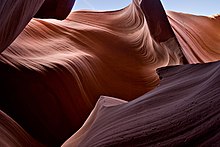Clastic sedimentary rocks
Main article: Clastic rock
Claystone deposited in Glacial Lake Missoula, Montana, United States. Note the very fine and flat bedding, common for distal lacustrine deposition.
Clastic sedimentary rocks, are subdivided according to the dominant particle size. Most geologists use the Udden-Wentworth grain size scale and divide unconsolidated sediment into three fractions: gravel (>2 mm diameter), sand (1/16 to 2 mm diameter), and mud (clay is <1/256 mm and silt is between 1/16 and 1/256 mm). The classification of clastic sedimentary rocks parallels this scheme; conglomerates and breccias are made mostly of gravel, sandstones are made mostly of sand, and mudrocks are made mostly of the finest material. This tripartite subdivision is mirrored by the broad categories of rudites, arenites, and lutites, respectively, in older literature.
The subdivision of these three broad categories is based on differences in clast shape:conglomerates and breccias), composition (sandstones), grain size and/or texture (mudrocks).
Conglomerates and breccias
Conglomerates are dominantly composed of rounded gravel, while breccias are composed of dominantly angular gravel.Sandstones
Sedimentary rock with sandstone in Malta
- Composition of framework grains
- The relative abundance of sand-sized framework grains determines the first word in a sandstone name. Naming depends on the dominance of the three most abundant components quartz, feldspar, or the lithic fragments that originated from other rocks. All other minerals are considered accessories and not used in the naming of the rock, regardless of abundance.
-
-
- Quartz sandstones have >90% quartz grains
- Feldspathic sandstones have <90% quartz grains and more feldspar grains than lithic grains
- Lithic sandstones have <90% quartz grains and more lithic grains than feldspar grains
-
- Abundance of muddy matrix material between sand grains
- When sand-sized particles are deposited, the space between the
grains either remains open or is filled with mud (silt and/or clay sized
particle).
- "Clean" sandstones with open pore space (that may later be filled with matrix material) are called arenites.
- Muddy sandstones with abundant (>10%) muddy matrix are called wackes.
- When sand-sized particles are deposited, the space between the
grains either remains open or is filled with mud (silt and/or clay sized
particle).
Although the Dott classification scheme[3] is widely used by sedimentologists, common names like greywacke, arkose, and quartz sandstone are still widely used by non-specialists and in popular literature.
Mudrocks
Lower Antelope Canyon was carved out of the surrounding sandstone by both mechanical weathering and chemical weathering. Wind, sand, and water from flash flooding are the primary weathering agents.
Most authors presently use the term "mudrock" to refer to all rocks composed dominantly of mud.[4][5][6][7] Mudrocks can be divided into siltstones, composed dominantly of silt-sized particles; mudstones with subequal mixture of silt- and clay-sized particles; and claystones, composed mostly of clay-sized particles.[4][5] Most authors use "shale" as a term for a fissile mudrock (regardless of grain size) although some older literature uses the term "shale" as a synonym for mudrock.
Biochemical sedimentary rocks
Outcrop of Ordovician oil shale (kukersite), northern Estonia
- Most types of limestone are formed from the calcareous skeletons of organisms such as corals, mollusks, and foraminifera.
- Coal, formed from plants that have removed carbon from the atmosphere and combined it with other elements to build their tissue.
- Deposits of chert formed from the accumulation of siliceous skeletons of microscopic organisms such as radiolaria and diatoms.




No comments:
Post a Comment